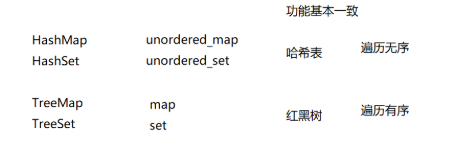1. unordered_set系列的使⽤
1.1 unordered_set和unordered_multiset参考⽂档
https://legacy.cplusplus.com/reference/unordered_set/
1.2 unordered_set类的介绍
• unordered_set的声明如下,Key就是unordered_set底层关键字的类型。
• unordered_set默认
要求Key⽀持转换为整形
,如果不⽀持或者想按⾃⼰的需求⾛可以⾃⾏实现⽀
持将Key转成整形的仿函数传给第⼆个模板参数。
• unordered_set默认
要求Key⽀持⽐较相等
,如果不⽀持或者想按⾃⼰的需求⾛可以⾃⾏实现⽀持
将Key⽐较相等的仿函数传给第三个模板参数。
• unordered_set底层存储数据的内存是从空间配置器申请的,如果需要可以⾃⼰实现内存池,传给
第四个参数。
• ⼀般情况下,我们都不需要传后三个模板参数。
• unordered_set底层是⽤哈希桶实现,
增删查平均效率是O(1)
,迭代器遍历不再有序,为了跟set
区分,所以取名unordered_set。
• 前⾯部分我们已经学习了set容器的使⽤,set和unordered_set的功能⾼度相似,只是底层结构不
同,有⼀些性能和使⽤的差异,这⾥我们只讲他们的差异部分。

1.3 unordered_set和set的使⽤差异
•
查看⽂档我们会发现unordered_set的⽀持增删查且跟set的使⽤⼀模⼀样,关于使用我们这⾥就不再赘述和演示了。
•
unordered_set和set的第⼀个差异是对key的要求不同,set要求Key⽀持⼩于⽐较,但是
unordered_set要求Key⽀持转成整形且⽀持等于⽐较,要理解unordered_set的这个两点要求得
后续我们结合哈希表底层实现才能真正理解,也就是说这本质是哈希表的要求。
•
unordered_set和set的第⼆个差异是迭代器的差异,set的iterator是双向迭代器,unordered_set
是单向迭代器,其次set底层是红⿊树,红⿊树是⼆叉搜索树,⾛中序遍历是有序的,所以set迭代器遍历是有序+去重。⽽unordered_set底层是哈希表,迭代器遍历是⽆序+去重。
•
unordered_set和set的第三个差异是性能的差异,整体而言⼤多数场景下,unordered_set的增删
查改更快⼀些,因为红黑树增删查改效率是O
(
logN),而哈希表增删查平均效率是O
(1),具体 可以参看下面代码的演示的对比差异。
#define _CRT_SECURE_NO_WARNINGS 1
#include<iostream>
#include<set>
#include<unordered_set>
using namespace std;
void test_set1()
{
unordered_set<int> s = { 3,1,6,7,8,2,1,1,5,6,7,6 };
unordered_set<int>::iterator it = s.begin();
while (it != s.end())
{
cout << *it << " ";
++it;
}
cout << endl;
}
void test_set2()
{
const size_t N = 10000000;
unordered_set<int> us;
set<int> s;
vector<int> v;
v.reserve(N);
srand(time(0));
for (size_t i = 0; i < N; ++i)
{
//v.push_back(rand()); // N比较大时,重复值比较多
//v.push_back(rand() + i); // 重复值相对少
v.push_back(i); // 没有重复,有序
}
size_t begin1 = clock();
for (auto e : v)
{
s.insert(e);
}
size_t end1 = clock();
cout << "set insert:" << end1 - begin1 << endl;
size_t begin2 = clock();
us.reserve(N);
for (auto e : v)
{
us.insert(e);
}
size_t end2 = clock();
cout << "unordered_set insert:" << end2 - begin2 << endl;
cout << "插入数据个数:" << s.size() << endl;
cout << "插入数据个数:" << us.size() << endl << endl;
int m1 = 0;
size_t begin3 = clock();
for (auto e : v)
{
auto ret = s.find(e);
if (ret != s.end())
{
++m1;
}
}
size_t end3 = clock();
cout << "set find:" << end3 - begin3 << "->" << m1 << endl;
int m2 = 0;
size_t begin4 = clock();
for (auto e : v)
{
auto ret = us.find(e);
if (ret != us.end())
{
++m2;
}
}
size_t end4 = clock();
cout << "unorered_set find:" << end4 - begin4 << "->" << m2 << endl;
size_t begin5 = clock();
for (auto e : v)
{
s.erase(e);
}
size_t end5 = clock();
cout << "set erase:" << end5 - begin5 << endl;
size_t begin6 = clock();
for (auto e : v)
{
us.erase(e);
}
size_t end6 = clock();
cout << "unordered_set erase:" << end6 - begin6 << endl << endl;
}
int main()
{
test_set2();
return 0;
}
1.4 unordered_map和map的使⽤差异
•
查看⽂档我们会发现unordered_map的⽀持增删查改且跟map的使⽤⼀模⼀样,关于使用我们这
⾥就不再赘述和演示了。
•
unordered_map和map的第⼀个差异是对key的要求不同,
map要求Key⽀持⼩于⽐较
,⽽
unordered_map
要求Key⽀持转成整形且⽀持等于⽐较
,要理解unordered_map的这个两点要求
得后续我们结合哈希表底层实现才能真正理解,也就是说这本质是哈希表的要求。
•
unordered_map和map的第⼆个差异是迭代器的差异,map的iterator是双向迭代器,
unordered_map是单向迭代器,其次map底层是红⿊树,红⿊树是⼆叉搜索树,⾛中序遍历是有
序的,所以map迭代器遍历是Key有序+去重。⽽unordered_map底层是哈希表,迭代器遍历是
Key⽆序+去重。
•
unordered_map和map的第三个差异是性能的差异,整体⽽⾔⼤多数场景下,unordered_map的
增删查改更快⼀些,因为红⿊树增删查改效率是O
(
logN
),⽽哈希表增删查平均效率是O(1
)。
pair<iterator,bool> insert ( const value_type& val );
size_type erase ( const key_type& k );
iterator find ( const key_type& k );
mapped_type& operator[] ( const key_type& k );1.5 unordered_multimap/unordered_multiset
•
unordered_multimap/unordered_multiset跟multimap/multiset功能完全类似,⽀持Key冗余。
•
unordered_multimap/unordered_multiset跟multimap/multiset的差异也是三个⽅⾯的差异,
key的要求的差异,iterator及遍历顺序的差异,性能的差异。





















 763
763

 被折叠的 条评论
为什么被折叠?
被折叠的 条评论
为什么被折叠?








